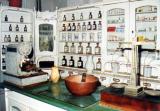2024. December 26. Thursday
Dr. István Jablonkay Region Historical Museum - Solymár
 |
Address: 2083, Solymár Templom tér 2.
Phone number: (70) 637-7499
E-mail: muzeum@apaczai.com
Opening hours: Wed 14-18, Thu12-16, Sat 9-14
|



